官网文档:How To Do @Async in Spring | Baeldung。
@Async注解

Spring框架基于@Async注解提供了对异步执行流程的支持。
最简单的例子是:使用@Async注解修饰一个方法,那么这个方法将在一个单独的线程中被执行,即:从同步执行流程转换为异步执行流程。
此外,Spring框架中,事件Event也是支持异步处理操作的。
@EnableAsync注解|核心接口
通过在配置类上添加@EnableAsync注解,可以为Spring应用程序启用异步执行流程的支持
@Configuration
@EnableAsync
public class SpringAsyncConfig { ... }该注解提供了一些可配置属性,

annotation:默认情况下,@EnableAsync会告诉Spring程序去探查所有被@Async注解修饰的、以及@javax.ejb.Asynchronous.注解;
mode:指定异步流程生效的方式:JDK Proxy还是AspectJ;
proxtTargetClass:只有在mode为AdviceMode.PROXY(JDK动态代理)时才会生效,用于指定要使用的动态代理类型:CGLIB或者JDK;
order:设置AsyncAnnotationBeanPostProcessor执行异步调用的顺序。
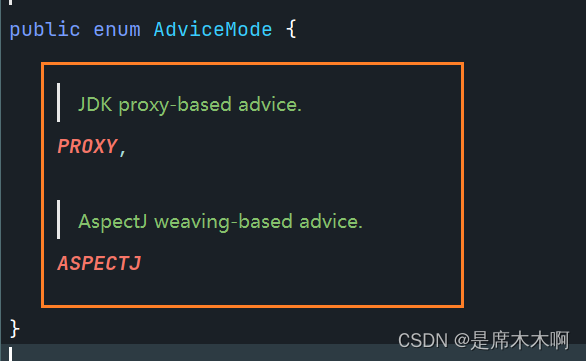

而在AsyncAnnotationBeanPostProcessor类的内部,则是通过TaskExecutor提供了一个线程池,来更加具体的负责执行某一个异步流程的。

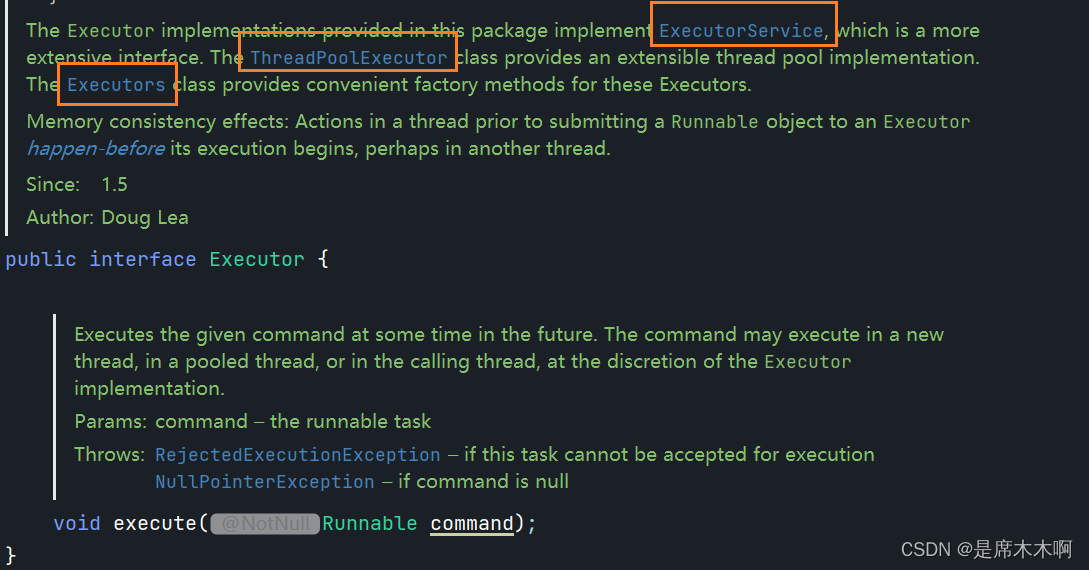
再往深入查看,就会发现,该接口的父接口Executor,与之相关的就是我们经常谈论的和并发编程相关的Executor框架了。
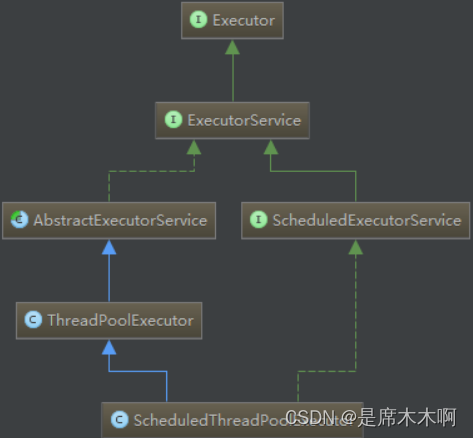
再看Spring框架内部提供的TaskExecutor接口的继承结构,如下图所示,
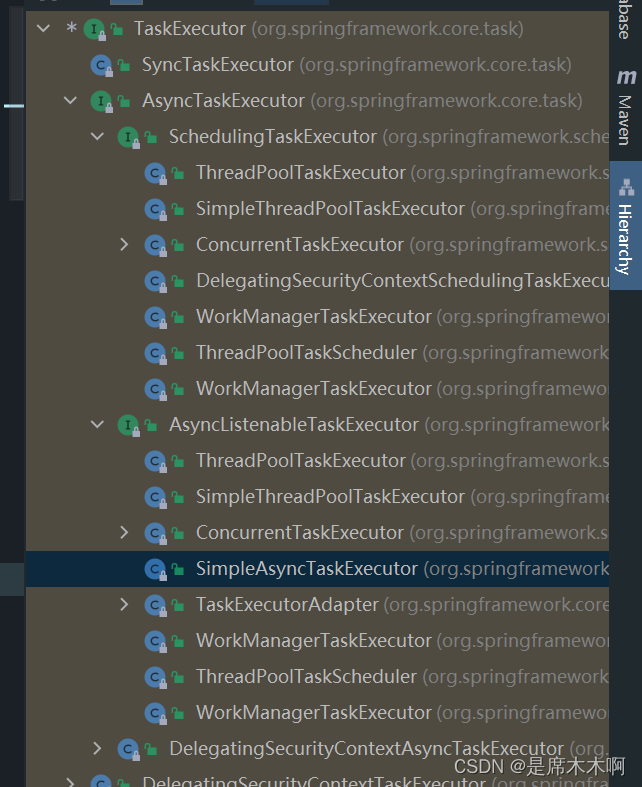
因此,要使用@EnableAsync注解开启异步流程执行的支持,可能就需要去对TaskExecutor接口实例的线程池参数进行配置。
<task:executor id="myexecutor" pool-size="5" />
<task:annotation-driven executor="myexecutor"/>SpringBoot默认线程池配置
根据以上解读,不难发现:其实SpringBoot内部是通过维护线程池的方式去执行异步任务的,那么,这个默认的线程池对应于Exector框架的哪一个实现子类?相关的配置参数又是什么呢?
要解决上述疑惑,需要先去找到TaskExecutionAutoConfiguration类,该类定义了默认注入的线程池实例及其配置参数。
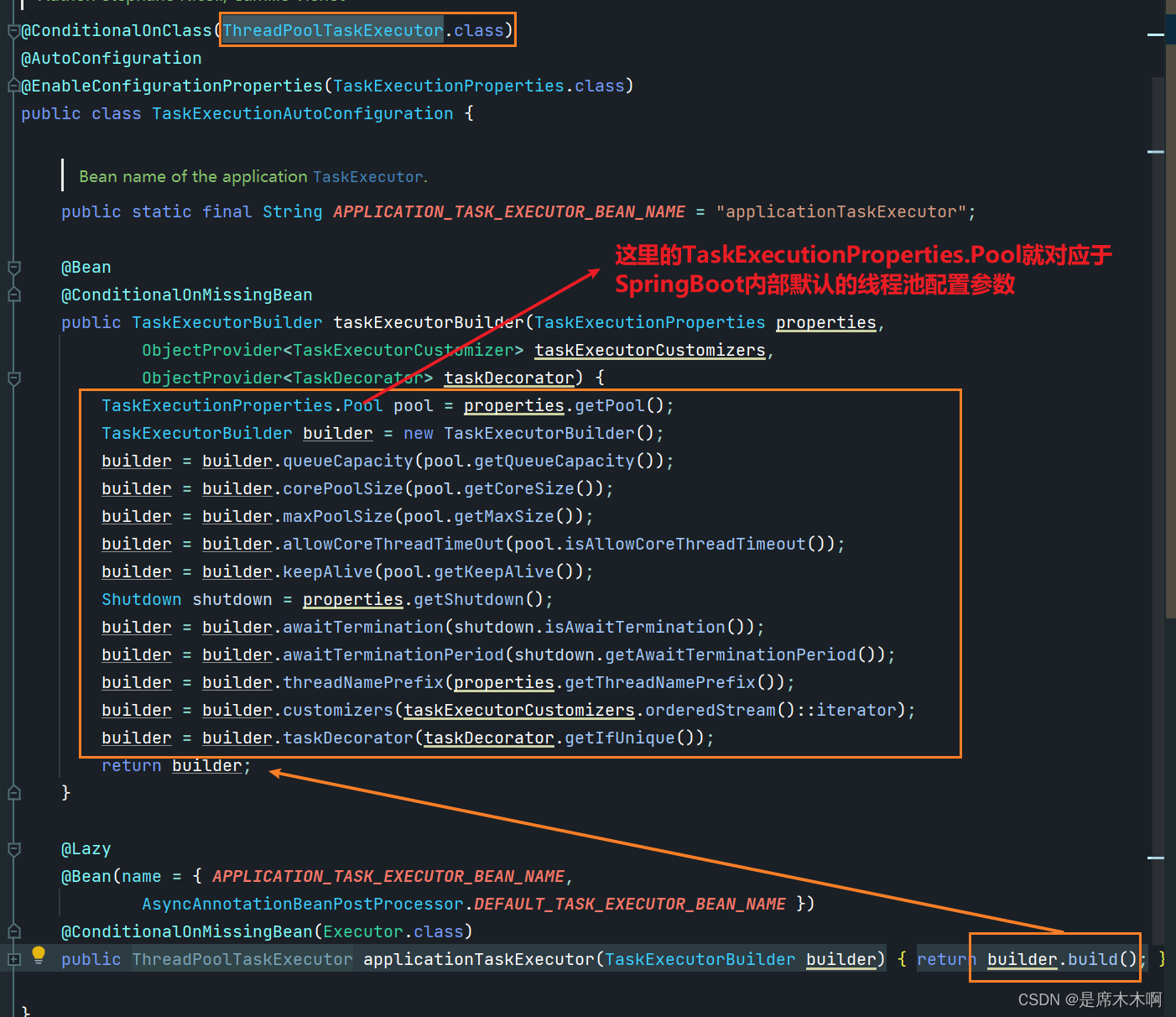
默认线程池类型:ThreadPoolTaskExecutor
默认线程池配置参数:TaskExecutionProperties.Pool
详细参数信息,对应于一个静态内部类Pool,源码如下,
public static class Pool {/*** Queue capacity. An unbounded capacity does not increase the pool and therefore* ignores the "max-size" property.*/private int queueCapacity = Integer.MAX_VALUE;/*** Core number of threads.*/private int coreSize = 8;/*** Maximum allowed number of threads. If tasks are filling up the queue, the pool* can expand up to that size to accommodate the load. Ignored if the queue is* unbounded.*/private int maxSize = Integer.MAX_VALUE;/*** Whether core threads are allowed to time out. This enables dynamic growing and* shrinking of the pool.*/private boolean allowCoreThreadTimeout = true;/*** Time limit for which threads may remain idle before being terminated.*/private Duration keepAlive = Duration.ofSeconds(60);public int getQueueCapacity() {return this.queueCapacity;}public void setQueueCapacity(int queueCapacity) {this.queueCapacity = queueCapacity;}public int getCoreSize() {return this.coreSize;}public void setCoreSize(int coreSize) {this.coreSize = coreSize;}public int getMaxSize() {return this.maxSize;}public void setMaxSize(int maxSize) {this.maxSize = maxSize;}public boolean isAllowCoreThreadTimeout() {return this.allowCoreThreadTimeout;}public void setAllowCoreThreadTimeout(boolean allowCoreThreadTimeout) {this.allowCoreThreadTimeout = allowCoreThreadTimeout;}public Duration getKeepAlive() {return this.keepAlive;}public void setKeepAlive(Duration keepAlive) {this.keepAlive = keepAlive;}}从中可以找到默认的配置参数,
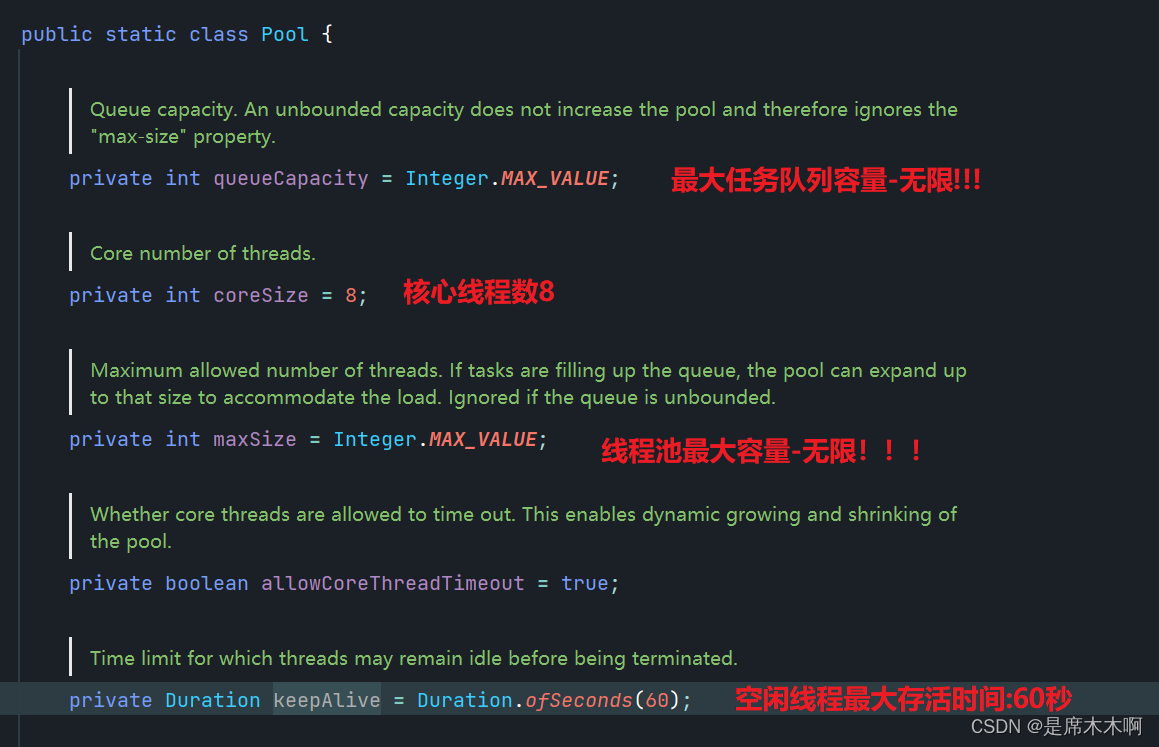
@Async注解使用
使用时的两个限制
1.它只能应用于公共方法
2.从同一个类中调用异步方法将不起作用(会绕过代理,而直接去调用底层方法本身)

注解修饰对象
查看@Async注解的源码,可看到:它用于修饰class、interface、method,并且提供了一个value属性,用于在@Autowired和@@Qualifier注解组合自动装配时,指定要使用哪一个线程池。因为原则上来讲,我们是可以通过@Bean注解,在一个Spring容器中注入多个线程池实例的。
package org.springframework.scheduling.annotation;import java.lang.annotation.Documented;
import java.lang.annotation.ElementType;
import java.lang.annotation.Retention;
import java.lang.annotation.RetentionPolicy;
import java.lang.annotation.Target;/*** Annotation that marks a method as a candidate for <i>asynchronous</i> execution.** <p>Can also be used at the type level, in which case all the type's methods are* considered as asynchronous. Note, however, that {@code @Async} is not supported* on methods declared within a* {@link org.springframework.context.annotation.Configuration @Configuration} class.** <p>In terms of target method signatures, any parameter types are supported.* However, the return type is constrained to either {@code void} or* {@link java.util.concurrent.Future}. In the latter case, you may declare the* more specific {@link org.springframework.util.concurrent.ListenableFuture} or* {@link java.util.concurrent.CompletableFuture} types which allow for richer* interaction with the asynchronous task and for immediate composition with* further processing steps.** <p>A {@code Future} handle returned from the proxy will be an actual asynchronous* {@code Future} that can be used to track the result of the asynchronous method* execution. However, since the target method needs to implement the same signature,* it will have to return a temporary {@code Future} handle that just passes a value* through: e.g. Spring's {@link AsyncResult}, EJB 3.1's {@link javax.ejb.AsyncResult},* or {@link java.util.concurrent.CompletableFuture#completedFuture(Object)}.*/
@Target({ElementType.TYPE, ElementType.METHOD})
@Retention(RetentionPolicy.RUNTIME)
@Documented
public @interface Async {/*** A qualifier value for the specified asynchronous operation(s).* <p>May be used to determine the target executor to be used when executing* the asynchronous operation(s), matching the qualifier value (or the bean* name) of a specific {@link java.util.concurrent.Executor Executor} or* {@link org.springframework.core.task.TaskExecutor TaskExecutor}* bean definition.* <p>When specified on a class-level {@code @Async} annotation, indicates that the* given executor should be used for all methods within the class. Method-level use* of {@code Async#value} always overrides any value set at the class level.* @since 3.1.2*/String value() default "";}
使用方式1:修饰方法method
根据上面的使用限制,被@Async注解修饰的方法,和主调方法不能位于同一个类中,并且也必须是public类型的公共方法。
package com.example.soiladmin;import org.springframework.scheduling.annotation.Async;
import org.springframework.stereotype.Component;//@Async注解测试类
@Component
public class AsyncTestMethod {@Asyncpublic void asyncTest(){try {System.out.println(String.format("start:%s",Thread.currentThread().getName()));Thread.sleep(1500);System.out.println(String.format("end:%s",Thread.currentThread().getName()));} catch (InterruptedException e) {e.printStackTrace();}}
}
调用方法,
注意到:被@Async修饰的方法线程睡眠了1.5s,如果它是异步执行的,那么就不会阻塞后面for循环的执行。
@Autowiredprivate AsyncTestMethod asyncTestMethod;@Testpublic void asyncTestMethod_1(){asyncTestClass.asyncTest();for (int i = 0; i < 10; i++) {try {Thread.sleep(300);System.out.println(String.format("i=%d\n",i));} catch (InterruptedException e) {e.printStackTrace();}}}打印结果,
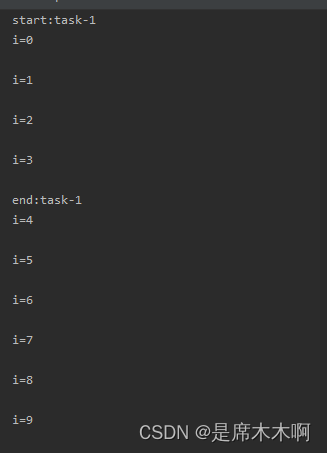
使用方式2:修饰类class
为了方便,我们直接将使用方式1中的类拷贝一份,然后使用@Async注解修饰class类,而非Method方法。
package com.example.soiladmin;import org.springframework.scheduling.annotation.Async;
import org.springframework.stereotype.Component;@Component
@Async
public class AsyncTestClass {public void asyncTest(){try {System.out.println(String.format("start:%s",Thread.currentThread().getName()));Thread.sleep(1500);System.out.println(String.format("end:%s",Thread.currentThread().getName()));} catch (InterruptedException e) {e.printStackTrace();}}
}
主调方法,
@Autowiredprivate AsyncTestClass asyncTestClass;@Testpublic void asyncTestClass_2(){asyncTestClass.asyncTest();for (int i = 0; i < 10; i++) {try {Thread.sleep(300);System.out.println(String.format("i=%d\n",i));} catch (InterruptedException e) {e.printStackTrace();}}}打印结果,
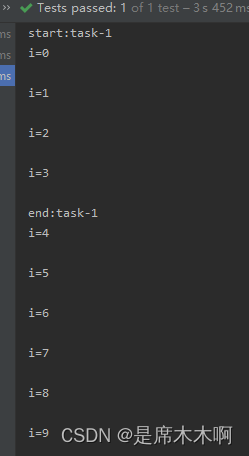
使用方式3:带返回值的方法
以上测试案例都是不带返回值的,但是一般情况下,我们可能还希望获取异步执行的结果,然后对结果进行合并、分析等,那么就可以为@Async注解修饰的方法声明一java.util.concurrent接口类型的返回类型。
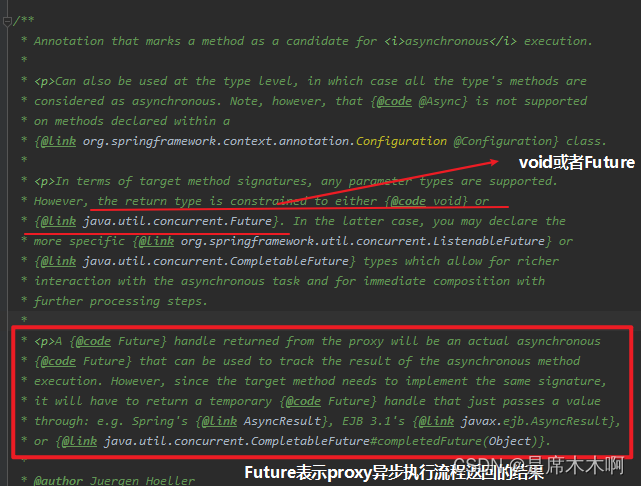
但是这里有一个注意点:就是要Future是一个接口,我们没办法直接去new一个接口,所以还要找到Future接口的实现子类。
比较常用的是Spring框架提供的实现子类AsyncResult,
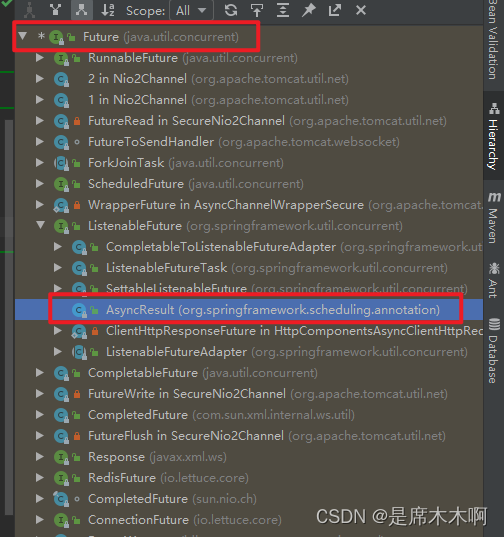
我们继续简单看一下AsyncResult实现子类的基本结构,
基本上提供了获取异步执行结果的get方法、对成功/失败情况进行处理的回调函数addCallBack、将返回结果继续进行封装为AsyncResult类型值的forValue,简单来讲,就是对jdk原生的concurrent包下的Future接口进行了功能拓展和增强。
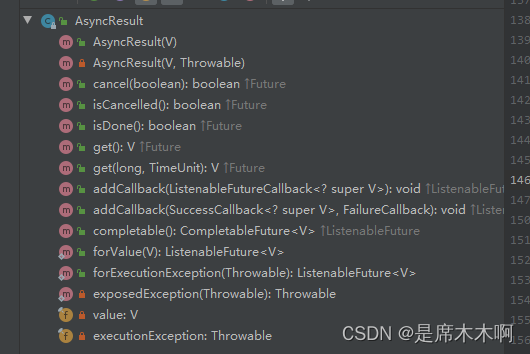
异步方法如下,
/*** 数列求和: An = 2 ^ n(n>=0),求累加和S(n)---这里为了测试效果(出于增加耗时考虑),不直接使用求和公式* @param n* @return*/@Asyncpublic ListenableFuture<Double> asyncSequenceSum(int n){Double sum = 0.0;for (int i = 1; i <= n; i++) {sum += Math.pow(2,i);}return new AsyncResult<>(sum);}测试方法如下,
以下两种方式都可以拿到执行结果,调用回调函数。
官网给的是第二种写法,
@Testpublic void asyncTestMethodWithReturns_nor(){System.out.println("开始执行...");ListenableFuture<Double> asyncResult = asyncTestMethod.asyncSequenceSum(10);//添加回调函数asyncResult.addCallback(new SuccessCallback<Double>() {@Overridepublic void onSuccess(Double result) {System.out.println("执行成功:" + result.doubleValue());}},new FailureCallback() {@Overridepublic void onFailure(Throwable ex) {System.out.println("执行失败:"+ex.getMessage());}});//直接尝试获取结果-[只能拿到结果,如果执行出错,就会抛出异常]try {Double aDouble = asyncResult.get();System.out.println("计算结果:"+aDouble.doubleValue());} catch (ExecutionException | InterruptedException e) {e.printStackTrace();}}@Testpublic void asyncTestMethodWithReturns_normal(){System.out.println("开始执行...");ListenableFuture<Double> asyncResult = asyncTestMethod.asyncSequenceSum(10);//等待执行结果while (true){if (asyncResult.isDone()){//直接尝试获取结果-[只能拿到结果,如果执行出错,就会抛出异常]try {Double aDouble = asyncResult.get();System.out.println("计算结果:"+aDouble.doubleValue());//添加回调函数asyncResult.addCallback(new SuccessCallback<Double>() {@Overridepublic void onSuccess(Double result) {System.out.println("执行成功:" + result.doubleValue());}},new FailureCallback() {@Overridepublic void onFailure(Throwable ex) {System.out.println("执行失败:"+ex.getMessage());}});} catch (ExecutionException | InterruptedException e) {e.printStackTrace();}//终止循环break;}System.out.println("Continue doing something else. ");}}执行结果,

自定义线程池配置参数

上面提到,SpringBoot内置了1个ThreadPoolTaskExecutor线程池实例,在实际开发中,根据需要,我们也可以结合@Configuration注解自定义新的线程池,也可以通过通过实现AsyncConfigurer接口直接替换掉原有的线程池。
定义新的线程池
这种情况下,Spring容器就会出现多个线程池实例,所以在使用@Async注解时,要通过value属性指定具体要使用哪一个线程池实例。
@Configuration
@EnableAsync
public class SpringAsyncConfig {@Bean(name = "threadPoolTaskExecutor")public Executor threadPoolTaskExecutor() {return new ThreadPoolTaskExecutor();}
}使用示例,
@Async("threadPoolTaskExecutor")
public void asyncMethodWithConfiguredExecutor() {System.out.println("Execute method with configured executor - "+ Thread.currentThread().getName());
}替换默认线程池
替换默认线程池需要实现AsyncConfigurer接口,通过重写getAsyncExecutor() ,从而让自定义的线程池变为Spring框架默认使用的线程池。
示例代码如下,
@Configuration
@EnableAsync
public class SpringAsyncConfig implements AsyncConfigurer {@Overridepublic Executor getAsyncExecutor() {ThreadPoolTaskExecutor threadPoolTaskExecutor = new ThreadPoolTaskExecutor();threadPoolTaskExecutor.initialize();return threadPoolTaskExecutor;}
}配置线程池参数
除了上述自定义新的线程池的方法,也可以通过SpringBoot配置文件,重新对默认线程池的参数进行修改。
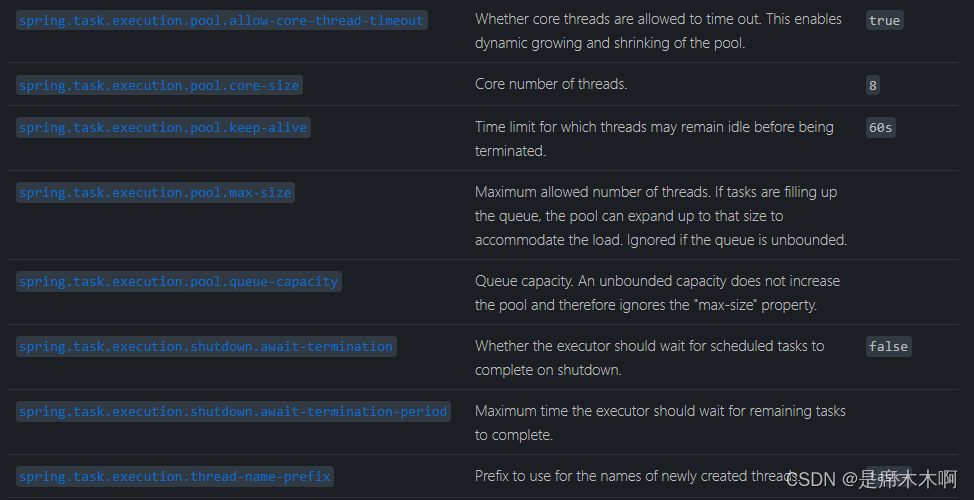
异步处理流程的异常处理
内置异常处理类:SimpleAsyncUncaughtExceptionHandler
SpringBoot框架内置的异常处理类为SimpleAsyncUncaughtExceptionHandler,仅仅是对异
常信息进行了打印处理。
package org.springframework.aop.interceptor;import java.lang.reflect.Method;import org.apache.commons.logging.Log;
import org.apache.commons.logging.LogFactory;/*** A default {@link AsyncUncaughtExceptionHandler} that simply logs the exception.** @author Stephane Nicoll* @author Juergen Hoeller* @since 4.1*/
public class SimpleAsyncUncaughtExceptionHandler implements AsyncUncaughtExceptionHandler {private static final Log logger = LogFactory.getLog(SimpleAsyncUncaughtExceptionHandler.class);@Overridepublic void handleUncaughtException(Throwable ex, Method method, Object... params) {if (logger.isErrorEnabled()) {logger.error("Unexpected exception occurred invoking async method: " + method, ex);}}}
当我们不做任何处理时,默认就是上述异常处理类在起作用。

继续向上扒拉源码,会发现它的父接口AsyncUncaughtExceptionHandler,其作用就是:指定异步方法执行过程中,抛出异常时的因对策略。
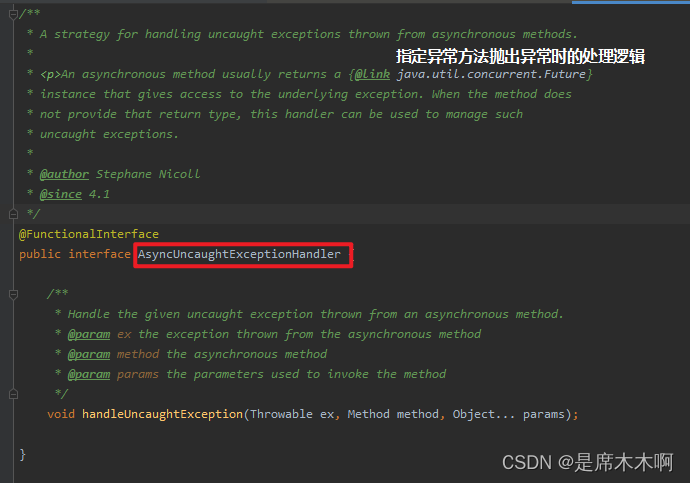
自定义异常处理类|配置
我们也可以通过实现接口AsyncUncaughtExceptionHandler,来自定义异常处理逻辑。
如下所示,为自定义的异常处理类:CustomAsyncExceptionHandler。
package com.example.soilcommon.core.async;import org.springframework.aop.interceptor.AsyncUncaughtExceptionHandler;
import org.springframework.context.annotation.Configuration;
import org.springframework.stereotype.Component;import java.lang.reflect.Method;/*** 异步处理流程异常处理类:* [1]对于返回值为Future类型的异步执行方法,异常会被抛出给主调方法* [2]对于返回值为void类型的异步执行方法,异常不会被抛出,即:在主调方法中没办法通过try...catch捕获到异常信息* 当前配置类针对情况[2]进行统一的异常处理*/
@Component("customAsyncExceptionHandler")
public class CustomAsyncExceptionHandler implements AsyncUncaughtExceptionHandler {/*** Handle the given uncaught exception thrown from an asynchronous method.* @param throwable the exception thrown from the asynchronous method* @param method the asynchronous method* @param params the parameters used to invoke the method*/@Overridepublic void handleUncaughtException(Throwable throwable, Method method, Object... params) {System.out.println("Exception message - " + throwable.getMessage());System.out.println("Method name - " + method.getName());for (Object param : params) {System.out.println("Parameter value - " + param);}}
}
接下来我们对其进行配置,使其生效,需要重写AsyncConfigurer接口getAsyncUncaughtExceptionHandler方法,
package com.example.soilcommon.core.async;import org.springframework.aop.interceptor.AsyncUncaughtExceptionHandler;
import org.springframework.aop.interceptor.SimpleAsyncUncaughtExceptionHandler;
import org.springframework.beans.factory.annotation.Autowired;
import org.springframework.beans.factory.annotation.Qualifier;
import org.springframework.context.annotation.Configuration;
import org.springframework.scheduling.annotation.AsyncConfigurer;
import org.springframework.scheduling.annotation.EnableAsync;@Configuration
@EnableAsync
public class AsyncConfig implements AsyncConfigurer {/*** 指定要使用哪一个具体的异常处理类* 原因:SpringBoot框架默认使用内置的SimpleAsyncUncaughtExceptionHandler进行异常处理*/@Autowired@Qualifier("customAsyncExceptionHandler")private AsyncUncaughtExceptionHandler asyncUncaughtExceptionHandler;/*** The {@link AsyncUncaughtExceptionHandler} instance to be used* when an exception is thrown during an asynchronous method execution* with {@code void} return type.*/@Overridepublic AsyncUncaughtExceptionHandler getAsyncUncaughtExceptionHandler() {return this.asyncUncaughtExceptionHandler;}
}
最终异步方法执行抛出异常时,打印的信息就是我们自定义的了,

参考文章:How To Do @Async in Spring | Baeldung


)
![[网鼎杯 2020 朱雀组]phpweb](http://pic.xiahunao.cn/[网鼎杯 2020 朱雀组]phpweb)
分类教程(样本制作、特征添加、训练、精度、最优参数、统计面积))






)
】最新解析及汽车驾驶员(中级)试题及解析)
)

)

)

